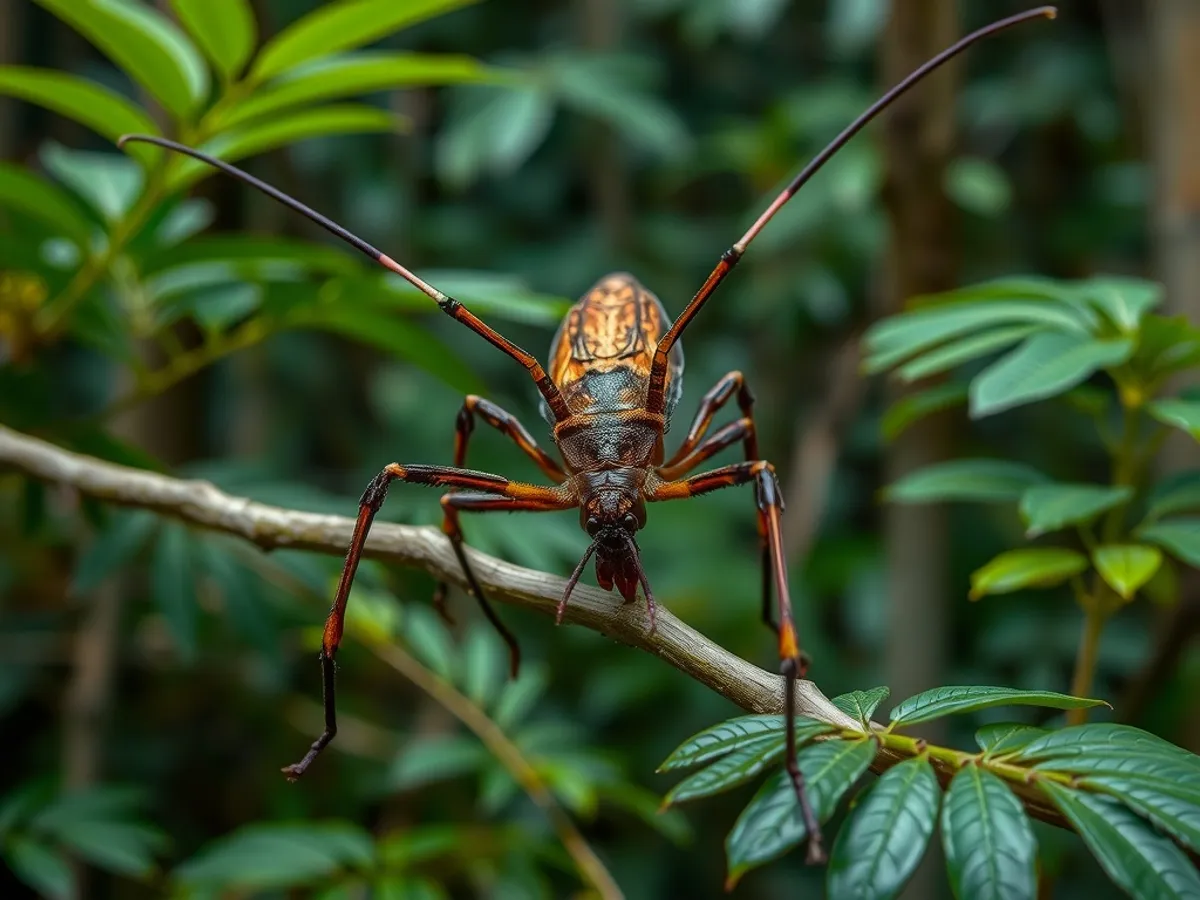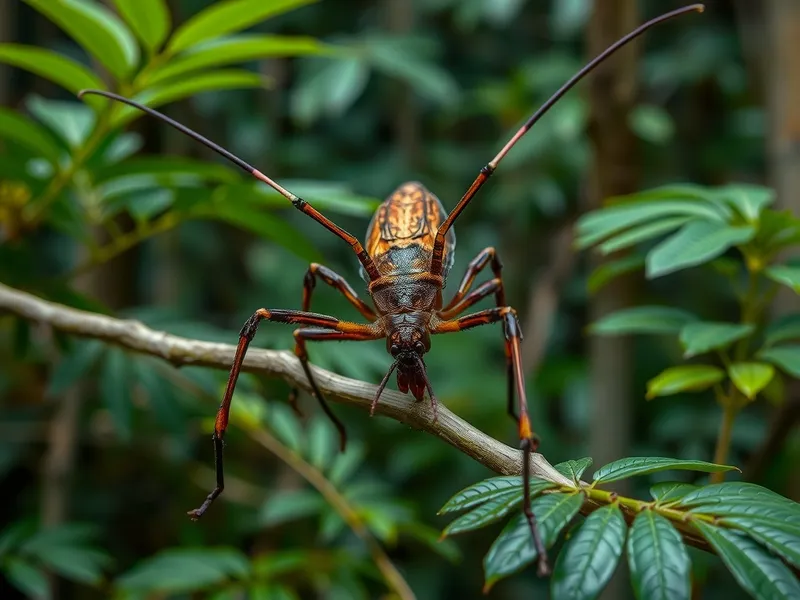
Giant Spiny Stick Insect
Extatosoma tiaratum

Meet the Giant Spiny Stick Insect
The Giant Spiny Stick Insect, also known as the Macleay's Spectre, is a large and remarkable insect native to Australia. Its body mimics dead leaves, complete with thorny spines and leaf-like projections for camouflage. Females are much larger than males and are recognized by their robust bodies and pronounced spines, while males have slender bodies and can fly. These insects are nocturnal, spending daylight hours motionless to avoid predators, and feed mainly on eucalyptus and other leaves. Their extraordinary mimicry and defensive behaviors make them a fascinating example of adaptation in the insect world.
Classification
Invertebrate
Habitat
Tropical and subtropical forests
Diet
Herbivore
Lifespan
12-18 months
Conservation
Least Concern
Weight
15-30 grams
📖Fascinating Facts
Impressive Mimicry
Their body shape and coloration allow them to blend seamlessly into foliage, resembling dried leaves and sticks.
Diet Specialization
They feed primarily on eucalyptus leaves but can also eat blackberry, raspberry, and bramble leaves in captivity.
Unique Egg Dispersal
Females drop eggs to the ground that resemble seeds with a cap called a capitulum, attracting ants that carry them underground, providing protection until hatching.
📋Detailed Description
The Giant Spiny Stick Insect (Extatosoma tiaratum) is one of the largest and most visually striking phasmids, with adult females reaching lengths of 15 cm (6 in) and males up to 12 cm (4.7 in). Females are robust, heavily spined, and flightless, while males are slender, less spiny, and capable of sustained flight thanks to their fully developed wings. Their exoskeleton is adorned with thorn-like projections and broad, leaf-like lobes on the legs and body, providing exceptional camouflage among foliage and dead leaves. The coloration varies from pale brown to green or mottled, often matching the host plant. Their head is small with long, thread-like antennae, and their legs are adapted for grasping branches. Nocturnal by nature, they remain motionless during the day, relying on their mimicry to evade predators such as birds and reptiles. When threatened, they display deimatic behavior, curling their abdomen and spreading their legs to appear larger and more intimidating. Females can also emit a defensive odor from glands to deter attackers. The species is primarily solitary, with limited social interaction outside of mating. Their remarkable mimicry extends to their eggs, which resemble plant seeds and are dispersed on the forest floor, sometimes collected by ants. This insect plays a significant ecological role as a herbivore, influencing plant dynamics in its native Australian habitats.
💡 Did you know?
When threatened, they can produce a clicking sound and release a defensive odor to deter predators.
🔬Research & Sources
🎭Behavior & Social Structure
Giant Spiny Stick Insects are primarily nocturnal, becoming active at dusk to forage for leaves, especially from eucalyptus, bramble, and acacia. They feed by slowly chewing on foliage, often remaining motionless for extended periods to avoid detection. When disturbed, they may sway gently, mimicking the movement of leaves in the wind. Defensive behaviors include curling the abdomen over the back in a scorpion-like posture, spreading limbs to exaggerate their size, and, in females, releasing a pungent odor. Social interactions are minimal; individuals are generally solitary except during the breeding season. Males are more active and mobile, often flying in search of females, while females are sedentary. Both sexes rely heavily on camouflage and stillness as primary anti-predator strategies.
👶Reproduction & Life Cycle
Reproduction in Extatosoma tiaratum is primarily sexual, though females are capable of parthenogenesis (asexual reproduction) in the absence of males. Mating typically occurs during the warmer months, with males locating females by following pheromone trails. After mating, females lay hundreds of eggs over several months, dropping them to the forest floor. The eggs are oval, about 4 mm long, and resemble seeds, which helps prevent predation. Incubation lasts 4-12 months depending on temperature and humidity. Upon hatching, nymphs (called 'instars') resemble ants in appearance and behavior, which may help them avoid predation during this vulnerable stage. There is no parental care; nymphs are independent from birth and undergo several molts before reaching adulthood, a process that takes 6-12 months.
🛡️Adaptations & Survival
Extatosoma tiaratum exhibits a suite of adaptations for survival. Its cryptic coloration and elaborate body projections provide exceptional camouflage, allowing it to blend seamlessly with twigs and leaves. The species' defensive behaviors, such as threat displays and the emission of a repellent odor, deter predators. The eggs' resemblance to seeds and their dispersal by ants (myrmecochory) reduce egg predation and aid in distribution. Nymphs mimic ants both visually and behaviorally, gaining protection from predators that avoid ants. Parthenogenesis enables females to reproduce without males, ensuring population persistence even when mates are scarce. Males' ability to fly increases their chances of locating females over large areas.
📚Research Sources
🎨Cultural Significance
The Giant Spiny Stick Insect is a popular species in educational programs and insect zoos worldwide, valued for its impressive size and unique appearance. In Australia, it is sometimes featured in indigenous stories and is recognized as a symbol of the country's rich biodiversity. The species is frequently used in scientific studies on camouflage, mimicry, and insect behavior. There are no known traditional medicinal or culinary uses, but its striking form has inspired art and natural history exhibits.
🔬Recent Research & Discoveries
Recent research on Extatosoma tiaratum has focused on its remarkable mimicry and the evolutionary mechanisms underlying its ant-mimicking nymphs. Studies have examined its chemical defenses, including the composition of its repellent secretions. Genetic research has explored the species' capacity for parthenogenesis and its implications for population genetics. Behavioral studies have documented the effectiveness of its threat displays and camouflage against various predators. The species is also used as a model organism in studies of insect development, molting, and reproductive strategies.
🎥Wildlife Videos

Giant Prickly Stick Insect
Looking more like a dead leaf than a stick, the Giant Prickly Stick Insect is a master of camouflage. Jorge Ribas visits the ...
Discovery

Wildlife - Just Insects | Free Documentary Nature
Wildlife - Episode 5: Just Insects | Wildlife Documentary Watch 'Wildlife - Episode 6' here: https://youtu.be/nfpzQyi9UFU Earth is ...
Free Documentary - Nature

Australian Walking Stick Insects Are Three Times Weirder Than You Think | Deep Look
The Australian walking stick is a master of deception, but a twig is just one of its many disguises. Before it's even born, it mimics a ...
Deep Look

The Stick Insect
This is a video of the stick insect taken from the BBC's Life in the Undergrowth documentary series.
globalzoo

They Warned NOT GET TOO CLOSE! World’s Most Dangerous INSECTS You Won’t Believe Exist! - Documentary
They Warned NOT GET TOO CLOSE! 20 Massive & Dangerous INSECTS That Are Actually Real - Documentary Welcome to ...
GlobeGo

10 Most Beautiful Stick Insects Ever Discovered
For copyright matters, contact us directly at: officialzonea@gmail.com 5 of the most beautiful / colorful / amazing / unique stick ...
ZoneA
🌍Habitat Information
The Giant Spiny Stick Insect typically inhabits Tropical and subtropical forests environments. Giant Spiny Stick Insects have adapted to their environments with specialized features and behaviors.
Primary Habitat:
Tropical and subtropical forests
More detailed habitat information will be available soon.
🛡️Conservation Status
The Giant Spiny Stick Insect is currently classified as Least Concern. Conservation efforts are crucial for preserving this species for future generations.
Common Threats:
- 🏠Habitat loss and fragmentation
- 🌡️Climate change impacts
- 🎯Hunting and poaching
- 🏭Human-wildlife conflict
⚠️Threats & Conservation Challenges
Currently, Extatosoma tiaratum is classified as Least Concern by the IUCN, with stable populations in its native range. However, localized threats include habitat loss due to deforestation and land conversion for agriculture. Invasive species and pesticide use may also impact populations. The species is popular in the pet trade, but captive breeding programs have reduced the need for wild collection. Climate change poses a potential long-term threat by altering the distribution of suitable habitats and host plants. Overall, the species is resilient, but ongoing habitat protection is important for its continued stability.
🔬Scientific Classification
Scientific Name
Extatosoma tiaratum
Classification Hierarchy
🔍 About Taxonomic Classification
Taxonomic classification is a hierarchical system used by scientists to classify and organize living organisms based on shared characteristics and evolutionary relationships.
The system moves from broad categories (Kingdom) to increasingly specific ones, with each animal's scientific name typically consisting of its Genus and species.
📝Community Notes
Share your observations and insights about the Giant Spiny Stick Insect with our community of wildlife enthusiasts.
Join Our Community
Sign in to share your observations and connect with fellow wildlife enthusiasts.
Sign In to ContributeNo community notes yet
Be the first to share your observations about the Giant Spiny Stick Insect!
Explore Giant Spiny Stick Insect
Select a tab above to learn more about this amazing animal.
📸Photo Gallery
No photos available for this animal yet.
🌟Discover More Wildlife
Continue your journey of discovery with more fascinating animals from our database
